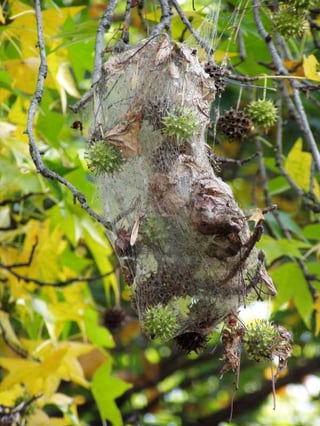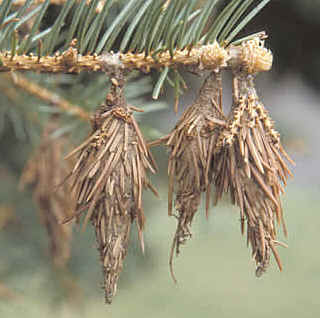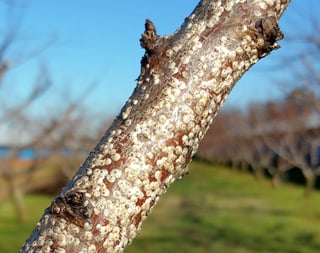
As we enter Fall, our landscapes turn from bright hues of green to shades of golden yellow, amber, and burnt orange. Our trees are going to sleep for the winter while a few pesky insects sneak in for their demise!
While these insects rarely do any damage, it is good to know a few facts and some good ways to spot and control them! 
Fall Webworm is a caterpillar that forms webs and are harmless! You can easily have the webs pruned out of the branches since the webs are formed on the tips. The best course of action is to let nature take its course! It's ok, the webworm has many enemies that feed on them so, you don't have to worry about them for long!
Interesting fact from the Missouri Botanical Gardens "A distinctive web of silk, containing many caterpillars, is constructed around leaves at branch ends. Each "nest" may contain hundreds of larvae that feed together for a while. By late summer, the unsightly nest may measure three feet across and in addition to the growing larvae, contains excrement, dried leaf fragments, and cast skins. An unusual characteristic of fall webworm caterpillars is that if alarmed, all the caterpillars in a nest make jerking movements in unison. It is thought that this is a potential defensive mechanism to startle and deter predators." Don't forget to sign up for their newsletter!
 Bagworms are another caterpillar that form bags instead of webs! No worries here, these guys have the same enemies that feed on them and are easily plucked out of the trees for disposal. Be sure to catch these early as they will spread quickly.
Bagworms are another caterpillar that form bags instead of webs! No worries here, these guys have the same enemies that feed on them and are easily plucked out of the trees for disposal. Be sure to catch these early as they will spread quickly.
Interesting fact from the Missouri Botanical Gardens again "From late May to mid-June, bagworm larvae(caterpillars) begin emerging from the bags. Almost immediately after emerging, a larva starts to produce its own protective bag. The bag is constructed such that the larva's head and legs are free. This construction allows the larvae to move about the plant as it feeds on the foliage. As the larva grows, it increases the size of its bag. The full-grown larvae are about one inch long".
Oak Mites; It's time for a visit from the end of the summer pain in the neck (literally) but typically harmless Oak Mites! You know, the little bugs dropping from your beautiful mature Kansas City Oaks eating your neck and arms while you mow your lawn! They are those tiny microscopic insects that you will never be able to see. The mites feed on larva of small fly which is what forms the brown crusty edges of Oak leaves (know as gall). There is nothing you need to do. Natural predators will keep the balance. 
Scale is a pretty common insect of many trees. These insects form a hard shell which protects them from predators. They pierce the twig and suck sap slowing the vigor and health of the tree. Serious infestations might require a professional to treat but using chemical treatments also kills the natural predators. 
